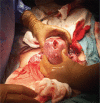Uterine rupture in pregnancy subsequent to hysteroscopic surgery: A case series
- PMID: 29379670
- PMCID: PMC5780571
- DOI: 10.4274/tjod.77642
Uterine rupture in pregnancy subsequent to hysteroscopic surgery: A case series
Abstract
Uterine rupture during pregnancy is associated with high mortality and morbidity rates in both the fetus and the mother. Hysteroscopic surgeries such as myomectomy and septum resection are known risk factors for uterine rupture in pregnancy following the operation. We present four infertile patients who were admitted to Kocaeli Medical Park Hospital between February 2014 and November 2016. Three of the patients underwent hysteroscopic septum resection without complication and one had hysteroscopic myomectomy and a 7-8 mm sized rupture was detected. All of the patients became pregnant in less than a year after the operations. The first three patients had uterine rupture at 22nd, 38th, and 10th week, which is the earliest rupture in the literature. The last patient had an uneventful pregnancy and the rupture was observed during cesarean section. A short interval between hysteroscopy and pregnancy may increase the risk of rupture. It may be possible to become pregnant despite rupture and not have any problems during the entire pregnancy.
Keywords: Hysteroscopy; pregnancy; uterine rupture.
Conflict of interest statement
Conflict of Interest: No conflict of interest was declared by the authors.
Figures
Similar articles
-
Uterine rupture after hysteroscopic resection of uterine septum.Fertil Steril. 2002 Mar;77(3):618-20. doi: 10.1016/s0015-0282(01)03222-8. Fertil Steril. 2002. PMID: 11872222
-
Uterine rupture at the 29th week of subsequent pregnancy after hysteroscopic resection of uterine septum.Fertil Steril. 2009 Mar;91(3):934.e1-3. doi: 10.1016/j.fertnstert.2008.08.075. Epub 2008 Dec 4. Fertil Steril. 2009. PMID: 19062010
-
Recurrent uterine rupture after hysterescopic resection of the uterine septum.Int J Surg Case Rep. 2013;4(2):182-4. doi: 10.1016/j.ijscr.2012.10.022. Epub 2012 Nov 21. Int J Surg Case Rep. 2013. PMID: 23276762 Free PMC article.
-
[Uterine rupture following operative hysteroscopy].Gynecol Obstet Fertil. 2006 Nov;34(11):1064-70. doi: 10.1016/j.gyobfe.2006.09.004. Epub 2006 Oct 17. Gynecol Obstet Fertil. 2006. PMID: 17052938 Review. French.
-
Late complications of operative hysteroscopy: predicting patients at risk of uterine rupture during subsequent pregnancy.Eur J Obstet Gynecol Reprod Biol. 2005 Jun 1;120(2):134-8. doi: 10.1016/j.ejogrb.2004.10.010. Eur J Obstet Gynecol Reprod Biol. 2005. PMID: 15925040 Review.
Cited by
-
Spontaneous fundal uterine rupture in a non-labouring 31-week twin pregnancy and unknown previous hysteroscopic adhesiolysis: A case report.Case Rep Womens Health. 2021 Feb 27;30:e00302. doi: 10.1016/j.crwh.2021.e00302. eCollection 2021 Apr. Case Rep Womens Health. 2021. PMID: 33732629 Free PMC article.
-
Uterine rupture in patients with a history of laparoscopy or hysteroscopy procedures: Three case reports.Medicine (Baltimore). 2019 May;98(20):e15491. doi: 10.1097/MD.0000000000015491. Medicine (Baltimore). 2019. PMID: 31096449 Free PMC article.
-
Effect of hysteroscopic septum resection on IVF/ICSI outcomes in women with septate uterus: a propensity-score retrospective matching study.Reprod Biol Endocrinol. 2025 Apr 8;23(1):53. doi: 10.1186/s12958-025-01378-z. Reprod Biol Endocrinol. 2025. PMID: 40200268 Free PMC article.
-
The Association between Placenta Implantation at Prior Myomectomy Locations and Perinatal Outcomes in Pregnant Women Who Previously Underwent One-Step Hysteroscopic Myomectomy.Gynecol Minim Invasive Ther. 2020 Apr 28;9(2):54-58. doi: 10.4103/GMIT.GMIT_94_19. eCollection 2020 Apr-Jun. Gynecol Minim Invasive Ther. 2020. PMID: 32676280 Free PMC article.
References
-
- Jansen FW, Vredevoogd CB, Van Hulzen K, Hermans J, Trimbos JB, Trimbos-Kemper TC. Complications of hysteroscopy: a prospective, multicenter study. Obstet Gynecol. 2000;96:266–70. - PubMed
-
- Munro MG. Complications of hysteroscopic,and uterine resectoscopic surgery. Obstet Gynecol Clin North Am. 2010;37:399–425. - PubMed
-
- Sentilhes L, Sergent F, Roman H, Verspyck H, Marpeau L. Late complications of operative hysteroscopy: predicting patients at risk of uterine rupture during subsequent pregnancy. Eur J Obstet Gynecol Reprod Biol. 2005;120:134–8. - PubMed
-
- Bradley LD. Complications in hysteroscopy: prevention, treatment and legal risk. Curr Opin Obstet Gynecol. 2002;14:409–15. - PubMed
-
- Aydeniz B, Gruber IV, Schauf B, Kurek R, Meyer A, Wallwiener D. A multicenter survey of complications associated with 21,676 operative hysteroscopies. Eur J Obstet Gynecol Reprod Biol. 2002;104:160–4. - PubMed
Publication types
LinkOut - more resources
Full Text Sources
Other Literature Sources



